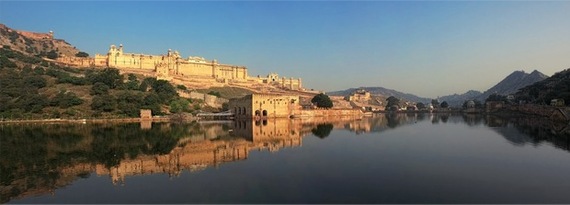In June of 2015, India's Prime Minister Narendra Modi launched the Smart Cities Challenge, a competition amongst Indian cities designed to accelerate and inspire more sustainable, citizen centric and effective urban development. The Ministry of Urban Development, which has been working with official knowledge partner Bloomberg Philanthropies on the Challenge, recently announced the first set of winning cities. C40 member city Jaipur was among the top finishers.
As Strategic Adviser to Jaipur Municipal Corporation in the preparation of its Smart City application, I had a front row seat to Jaipur's journey to the top of the competition. Here is my take on what made it happen.
Jaipur, capital city of the northwestern state of Rajasthan, is part of the 'Golden Triangle' - comprised of Delhi, Agra and Jaipur - one of the most visited tourist destinations in India. The city's economy grew at a rate of 12% between 2011-2014, compared to the national average of 7%. This impressive growth has made the city one of the most dynamic in India, but progress towards becoming a global city inevitably creates challenges.
Tourism and Heritage, the city's primary revenue generator, has been adversely affected by deteriorating air quality, unhygienic conditions of streets and neighborhoods often visited by tourists, and unsafe walking environments. The real-estate boom has also spurred building growth in the walled city of Jaipur that was not consistent with the traditional built form, thus eroding the built heritage and cultural ethos of the city.
Fortunately, the Smart Cities Challenge is helping Jaipur address these issues by taking a holistic approach to urban development. Crucially, the actions that will be introduced as part of the Challenge are based on a comprehensive survey of what citizens of Jaipur want to see. The Jaipur Municipal Corporation was able to reach out to close to 53% of its population through face-to-face meetings, online polls, ward-level consultations, SMS campaigns, social media and college/university interactions. This robust process of citizen outreach resulted in a clear set of priorities - with Tourism and Heritage topping the list - and the following Smart City Vision: "Jaipur Smart City aspires to leverage its Heritage and Tourism, and through Innovative and Inclusive solutions, enhance the Quality of Life for its Citizens" - the key words here are aspire, leverage, innovate, inclusive, and quality of life.
Jaipur's citizens also identified Transport & Mobility and Solid Waste Management as top areas for improvement. As part of a city-wide transport/mobility proposal, the city plans to leverage information and communications technology (ICT) and data driven measures to integrate different modes of transportation. City of Jaipur also devised an integrated Solid Waste Management proposal with emphasis on achieving at-source segregation, public cleanliness, hygiene, and sustainability, as well as citizen participation in monitoring and managing street waste collection.
It is critical to highlight here that throughout their application process the City of Jaipur realized that proposals at the city-wide level had to be interconnected with actions taking place at a more local, area-based level. Therefore as part of the area based proposal, a precinct of the historic walled city of Jaipur has been selected for demonstration projects to improve street intersections, improve the environment for pedestrians, correct road geometry, and transit-support infrastructure such as signage, street lighting, drinking fountains, garbage bins etc. Replicability, scalability and measurability of these area-based projects is key - only once the data on the impact of the changes has been gathered, assessed and shared with the community, will the model be replicated city-wide.
Another unique aspect of Jaipur's Smart City application was its approach to setting up baselines and benchmarks against which impacts could be measured. Jaipur took particular interest in quality of life metrics - such as perception of safety, security, road fatalities/accidents, air quality, etc. - which became the building blocks for setting up baseline indicators.
Looking ahead, Jaipur is sure to face some challenges - both institutional and technical - in implementing its Smart City proposal, but there is optimism and a sense of direction in the goals and vision that has been laid out. Additionally, the city is now putting in place a system that will start collecting and analyzing data to measure the impact of projects. Such efforts will not only build capacity in the long term, but will also allow the city to make decisions based on real-time data and accurate analytics.
I cannot end this reflection on Jaipur's journey without mentioning the role of Honorable Mayor of Jaipur Municipal Corporation Mr. Nirmal Nahata and Jaipur Municipal Corporation Commissioner Mr. Ashutosh A T Pednekar, who were ably supported by Additional Commissioner Mr. Rakesh Sharma. All of them displayed immense dedication and determination by stressing the importance of the process that was followed in preparing the Smart City application. This change in attitude is new to Indian cities, which I believe was the game-changer in Jaipur's case.
Congratulations to Jaipur on this great achievement - I am confident you are well and truly on your way to becoming a smart and sustainable global city.
All statistics mentioned in this blog have been sourced from Jaipur's Smart City application, which is available here.
To learn more about the India Smart Cities Challenge, please click here.
To learn more about Bloomberg Philanthropies' role in the India Smart Cities Mission, please click here.
